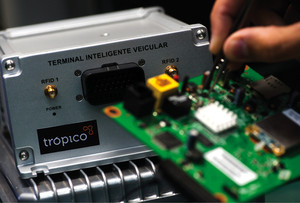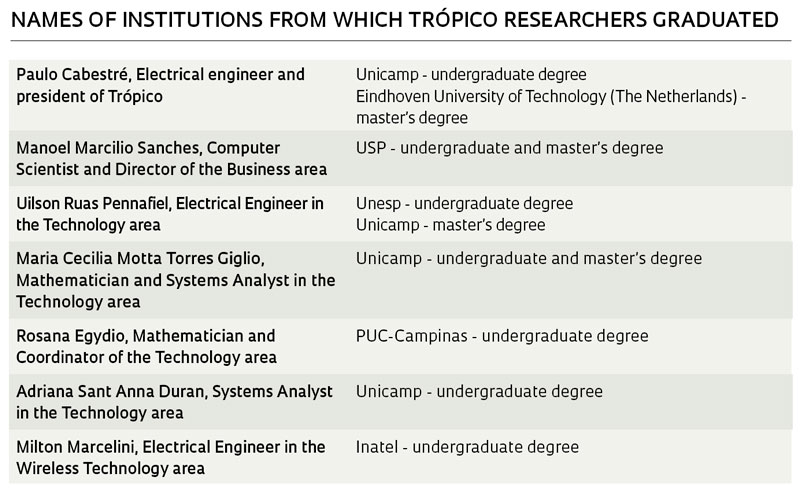
Léo Ramos Chaves
Digital switchboard telephone exchange (Trópico RA) at the product development and quality testing laboratoryLéo Ramos ChavesIncreasing its investments in research and development and broadening its portfolio to offer new technological solutions is the strategy chosen by Trópico Sistemas e Telecomunicações to continue to grow. Headquartered in Campinas, the Company was founded in 1999 as a spin-off of the Center for Research and Development in Telecommunications (CPqD), the former research center of the old Telebrás System, which had been privatized a year earlier. Trópico was created to develop and manufacture telecommunications equipment, with an initial focus on telephone switchboards. It was the first Brazilian company to produce digital exchanges in the 1980s. Years later, it introduced the Vectura Softswitch, a large-scale call controller, the equipment that replaced the digital exchanges. Its systems, installed at carriers such as Vivo, Oi and several small and mid-size carriers, control 1.3 billion phone calls a day. Twenty percent of all digital exchanges installed in Brazil, the equivalent of 9.5 million terminals, were manufactured by Trópico.
During the first 15 years of its activities, Trópico concentrated on telephony. This orientation began to change at the end of 2014, when control of the company changed hands from the Promon Group, the majority shareholder since its founding, to CPqD, which had been the minority shareholder and today is a non-profit focused on the development of new technologies for the telecommunications and information technology industries. “Under the new management of CPqD, Trópico re-invented itself and expanded its portfolio,” says Paulo Cabestré, president of Trópico. Without consistent investment in R&D, its product line had become outdated and the company shrank.
Sales fell to R$50 million in 2014, after exceeding R$200 million in 2008. “Trópico realized that it needed to go back to investing in R&D in new products and markets. We updated our portfolio, the core of which was the Vectura Softswitch, and we released two solutions: wireless broadband 4G communications systems and the virtualization of network functions, which is the technology in line with the recent trend of using cloud computing in telecommunications services,” says Cabestré. With a degree in electrical engineering from the University of Campinas (Unicamp), he left the board of CPqD Convergent Networks to assume command at Trópico in December 2014.
| Company |
| Trópico |
| R&D Center |
| Campinas (SP) |
| Nº of employees |
| 68 |
| Principal products |
| Telecommunications equipment and systems |
Since then, the Company has been investing 20% of its net revenues in R&D, totaling an average of R$11.4 million per year. In 2015 and 2016, sales were about R$60 million, and the forecast is for them to reach R$68 million this year.
The first of the new solutions developed by Trópico was a network element virtualization platform, dubbed Vectura Virtual Edge. “Virtualizing a network element or function, such as the internet access modem of the pay TV company, means bringing the ‘intelligence’ contained in this device to the cloud; in other words, to a server installed at the pay TV company or internet provider,” explains Cabestré. With this, the principal intelligent activities of the modem are transferred to a software program installed in a virtual environment, which provides centralized control within the cloud of functions that had previously been performed at the user’s residence. In practice, those little electronic boxes connected to the TV cable will not necessarily disappear, but they will become smaller and simpler.

Léo Ramos Chaves
Paulo Cabestré, president of Trópico since 2014Léo Ramos ChavesAccording to the president of Trópico, the customer terminal virtualization model reduces the number of technician visits for maintenance and facilitates the introduction of new services. “The virtualization of network elements is a recent technological breakthrough,” says Cabestré. He points out that no country uses this technology in a massive way. In Brazil, Trópico is testing a version of the product with a pay TV company which he would not identify.
The second area that Trópico is now betting on is broadband communications systems focused on the Internet of Things, a recent concept that refers to the possibility that electronic devices could be used in daily life, such as home appliances, farm machinery, industrial equipment or means of transportation, communicating among themselves using sensors and wireless communications networks. “We developed compact base radio stations and specialized exchanges for fourth generation networks (4G), at frequencies below 1 Gigahertz (GHz), which allow coverage over a radius of up to 50 kilometers,” says William Viais, technology manager at Trópico. “These characteristics make the stations appropriate for Brazil, since they can cover vast regions where population density is low.”
Developed in partnership with CPqD, this solution is aimed at the agribusiness, energy, defense and public safety markets. For example, electric utility companies can use the broadband communication system to automate the action of their reclosers–devices installed in aerial electric power lines to protect them from temporary problems. When there is an interruption in the electricity supply, such as when a tree falls on a certain point of the transmission line, a controller could selectively turn the network back on from a remote location, in real time, isolating the interruption point, using the wireless communications technology developed by Trópico. A team would not need to go to the location to work on the network.

Léo Ramos Chaves
Servers that enable virtualization of the traditional digital exchanges to the new generation network standardsLéo Ramos ChavesThe history of Trópico began well before the Company was founded. In 1973, under an agreement between the University of São Paulo (USP) and Telebrás, then the holding company of the Brazilian communications carriers, the concept of a national digital switchboard was developed to replace imports of analog exchanges. At that time, no Brazilian company possessed the technology to manufacture this equipment, which connects customers during a call. Three years later, with the founding of CPqD, the project team was transferred from the USP Polytechnic School (Poli) to Campinas.
In 1984, CPqD launched the Trópico R central exchange, with capacity for 10,000 customers. “It was a success because it met the specific conditions of the Brazilian network,” remembers Armando Barbieri, Trópico product marketing manager. “Trópico R was designed, for example, so that it did not require forced ventilation for cooling, so it could tolerate the extremes of temperature and humidity in Brazil. This made it quite robust, with a much lower failure rate than the imported products.” Given the favorable response to Trópico R, CPqD set out to design a telephone switchboard with the capacity for 100,000 lines, Trópico RA. Using a bold software architecture, it had mechanisms to ensure high performance. “In 1990, that effort resulted in the first large-scale exchange developed in Brazil,” Barbieri points out.
The privatization of the Telebrás System in 1998 brought an end to the investment of part of the carrier revenues in CPqD product development. Continuation of the Trópico Project was possible only after a new company was founded in 1999, dedicated to the manufacture, sale and continued technological improvement of digital exchanges. Thus, Trópico Sistemas e Telecomunicações was born, controlled by Promon (60% of the capital stock), by CPqD (30%) and by the U.S. company Cisco (10%), one of the leading global companies in information technology. “At that time, Brazil lacked innovative companies in the telecommunications area. And Trópico was created to fill that space,” notes Sebastião Sahão Júnior, current president of CPqD.

Léo Ramos Chaves
Media development center in the Trópico hardware laboratoryLéo Ramos ChavesTechnological evolution
At the end of the 1990s, the telecommunications industry underwent a major transformation with the appearance of the New Generation Networks (NGN), in which voice began to be transmitted by a database based on IP, the internet protocol. The architecture of Trópico RA was flexible enough to assimilate NGN technology. The new line of products was baptized Vectura. Five years later, in 2004, the Company made the first sale of its large-scale call controllers (for more than 800,000 users), the Vectura Softswitch (VSS). “That solution began to adopt the technology known as Voice over Internet Protocol, or VoIP, replacing the digital exchanges based on circuit switching,” affirms Victor Valenzuela. A consultant in the telecommunications field, he knows Trópico well, having participated in the development of its first exchanges in the 1980s.
The modernization of Trópico’s portfolio and the development of technological solutions are the responsibility of a team composed of 50 researchers. The Company has another 18 employees who provide customer service and technical support. “Through this service, new demands are received and introduced as improvements to the products,” explains William Viais, technology manager. He also points out that Trópico has a group of partner companies that work with its technology team on the development of certain parts of the products and solutions. “We have many partners, especially CPqD itself.”
Republish